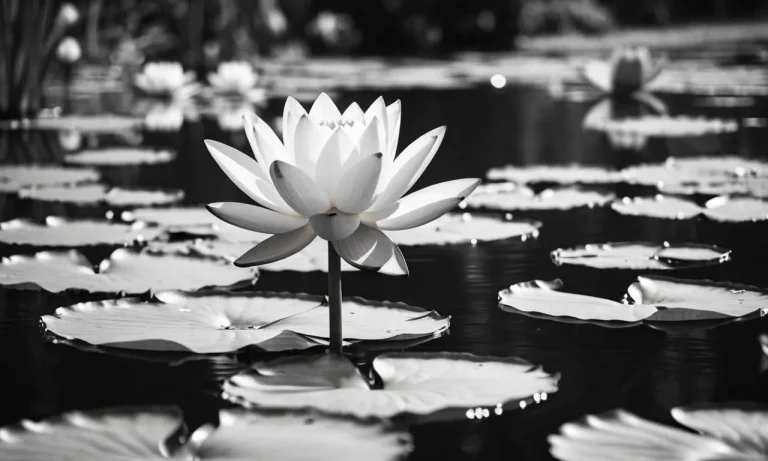The blue lotus flower has been a spiritual symbol in several ancient cultures and religions. If you’re short on time, here’s a quick answer to what the blue lotus flower spiritually symbolizes: wisdom, intelligence, logic, knowledge, and truth.
In this comprehensive guide, we will explore the deeper spiritual meaning and symbolism of the vibrant blue lotus. We’ll look at its history, its use in ancient Egypt, Buddhism, and Hinduism, and what it represents about the human pursuit of truth and enlightenment.
The History and Origins of the Blue Lotus Flower
Native Habitat and Botanical Description
The blue lotus (Nymphaea caerulea) is a water lily known for its light blue flowers. Native to the Nile River and other areas of East Africa, it has spread to other regions of the world, including India and parts of Southeast Asia.
Botanically, the blue lotus is an aquatic perennial plant that belongs to the Nymphaeaceae family. The intricate blue flowers feature broad petals emerging from the water on individual stems. Interestingly, the flowers only fully open in sunlight, closing at night.
Significance in Ancient Egypt
In ancient Egyptian culture, the blue lotus was a sacred symbol of life, death, and regeneration. Egyptians saw the plant’s daily cycle of opening and closing its flowers to the sun as symbolic of the cycle of life.
As such, the blue lotus frequently appeared in ancient Egyptian funerary art and architecture to represent the continuous renewal offered in the afterlife. It was also associated with the Egyptian sun god Ra as a symbol of creation and rebirth.
Meaning in Buddhism
In Buddhism, the blue lotus holds deep spiritual meaning representing purity of the body, speech, and mind. The flower grows unblemished from the mud, symbolizing achievement of enlightenment from the confines of human desire.
Widely referenced in Buddhist scriptures and teachings, the blue lotus serves as a metaphor for detachment from ego and liberation of the soul to reach Nirvana.
Symbolism in Hinduism
The blue lotus likewise carries spiritual symbolism in Hinduism where it represents learning, intelligence, wisdom, and knowledge. Positioned on the sixth chakra or ajna chakra, the blue lotus is said to embody a higher state of consciousness and spiritual vision.
Accordingly, Hindu deities like Brahma, Vishnu, Krishna and Saraswati are often depicted seated atop a blue lotus in meditative pose, reflecting purity and transcendence.
What Does the Blue Lotus Flower Represent?
Wisdom and Intelligence
The blue lotus flower has been a symbol of wisdom and intelligence for thousands of years. Ancient Egyptian and Hindu traditions linked the flower to the continual expansion of consciousness and awareness. The blue lotus encourages us to seek truth, ask questions, and break down barriers of the mind.
Mind Over Matter
The blue lotus flower teaches us that we can overcome attachment and desire. Like the lotus rising immaculate from muddy swamps, we too can transcend the suffering of the physical world. The blue lotus reminds us that with wisdom, practice and patience, we have the power to transform our inner realities.
An old Buddhist tale says that monks used to meditate staring at the blue lotus rising from the mud, focusing single-pointedly to achieve a state beyond attachment. The blue lotus flower has therefore become a symbol of non-attachment and equanimity amidst trying conditions.
Breaking Through Illusion
The closed blue lotus flower represents a time before full enlightenment, when we are still trapped in illusions and attachments. The partially opened flower signifies the beginning of enlightenment, as wisdom starts to break down barriers.
Finally, the fully bloomed lotus represents full awareness and liberation.
So the blue lotus reminds us that we too can break out of false realities. With truth as our guide, we can peel back limiting beliefs and expand understanding of ourselves and the world. The blue lotus gives us hope that it’s possible to see things clearly.
Rebirth and Renewal
The life cycle of the blue lotus flower mirrors stages of spiritual growth. From the darkness of the mud, through fresh shoots and leaves reaching for the sun, to the magnificent fully opened blue lotus in bloom – we are reminded that continual rebirth and renewal awaits.
Each stage of opening represents the shedding of limiting beliefs to allow for new wisdom and awareness to take root. So the blue lotus signals that rebirth into higher levels of consciousness comes through cycles of learning, integrating and letting go.
| Blue Lotus Stage | Spiritual Meaning |
|---|---|
| Closed Flower | Trapped in Illusions |
| Partially Opened Flower | Awakening Occurring |
| Fully Bloomed Open Flower | Enlightenment and Liberation |
The blue lotus flower reminds us that we all carry an infinite capacity for growth, healing, and transformation within us. Its quiet beauty encourages us to nurture those precious interior seeds, and let wisdom bloom.
The Blue Lotus Flower in Iconography and Art
Use in Ancient Egyptian Art and Architecture
The blue lotus flower (Nymphaea caerulea) held great spiritual and symbolic meaning in ancient Egyptian iconography and architecture. It was closely associated with the Sun god Ra as a symbol of creation and rebirth.
The blue lotus was often depicted in ancient Egyptian artwork, architecture, and artifacts found in tombs and temples:
- Lotus flowers lined the ceremonial paths of temples leading to thrones and shrines
- Intricately carved stone lotus columns held up temple roofs
- Stylized lotus designs embellished hieroglyphic frescoes, paintings, architectural decoration
- Lotus motifs featured prominently on jewelry, pottery, furnishings found in tombs
The blue lotus likely emerged alongside the Sun from the primaeval waters at the dawn of creation. It opened and closed with the Sun, mirroring Ra’s cycle of birth and renewal. The flower served as the seat of the first god Atum, symbolizing the origins of life.
Depictions in Buddhist Artwork
In Buddhism, the blue lotus flower represents purity of body, spirit and mind. It is rooted in the mud, yet blossoms immaculately above the water untainted. This ability to emerge unstained from the mud symbolizes achieving spiritual perfection amidst worldly attachment and desire.
The blue lotus commonly appears in ancient Buddhist temple iconography and artwork alongside other auspicious symbols:
| Iconography | Meaning |
| Buddha seated on a lotus | Overcoming suffering by rising above worldly illusions |
| Lotus pedestals | Support for divine enlightened beings |
| Lotus held by deities | Emblem of spiritual openness and purity |
Its presence conveys ideals of mental clarity and non-attachment amidst the shifting tides of samsara. The lotus reminds us we too can transcend illusion and suffering to uncover our innate Buddha nature.
Representations in Hindu Iconography
In Hinduism, the blue lotus flower represents the sixth primary chakra called Ajna, the center of intuition and spiritual insight. Known as the third-eye chakra, Ajna features prominently in Hindu iconography relating to consciousness and the mind.
Key examples include:
- Deities such as Shiva or Buddha depicted with a lotus flower sprouting from their forehead indicating spiritual awareness
- Goddess Saraswati, seated upon a lotus symbolizing awakened intelligence and creative wisdom
- The statement “to open the lotus of the heart” meaning to seek self-realization
The blue lotus conveys ideals of inner sight, allowing one to see past illusion to truth and meaning. Its presence connects the viewer to higher states of awareness and understanding.
Cultivating the Qualities of the Blue Lotus in Your Life
Seeking Truth Through Contemplation
The blue lotus flower encourages us to seek truth through quiet contemplation and looking within (Conscious Lifestyle Magazine). Just as the lotus rises pure and clean out of muddy waters, we can transcend the “muck and mire” of everyday life by taking time for inner reflection.
Find a quiet space, disconnect from technology and external stimuli, and allow insights and clarity to surface.
Contemplation opens our minds to truth and new perspectives. According to Buddha, we enter the “real” world when we go within and experience the spaciousness of our own minds. This echoes the blue lotus meaning of seeing past illusions into deeper reality.
Opening Your Mind to New Perspectives
The blue lotus flower teaches us to have an open, childlike mind so that we can truly perceive the world (Tiny Rituals). Children innately see things as they are without preconceived biases. The blue lotus asks us to get into this state of receptive awareness where we release our assumptions and open to new ways of thinking.
Imagine possibilities you hadn’t considered before. Be willing to admit, “I don’t know” as this leads to discovery and growth. See familiar things with new eyes, innocent of judgment.
Letting Go of Attachments
The closed blue lotus flower represents attachments and clinging in our lives. As the lotus opens fully to the sun, it demonstrates letting go and opening to enlightenment (The Little Book of Hindu Deities).
Similarly, we must detach from relationships, belief systems, and ways of thinking that no longer serve our higher purpose. What limiting mindsets or toxic connections is it time to release?
Trust that your true nature is unconditional love. Attachment to particular outcomes blocks this flow of love. Practice non-judgmental awareness in each moment. Know that all emotions and conditions are temporary, without latching onto them.
Conclusion
The vibrant blue lotus has been a spiritual symbol for cultures and faiths for thousands of years. With its representations of wisdom, intelligence and breaking through illusion to truth, embracing the energy of the blue lotus can help us on our own path to enlightenment.
By opening our minds to new perspectives, seeking truth through contemplation, and avoiding clinging to particular outcomes, we tap into the blue lotus qualities of clarity and liberation. Just as the flower rises immaculately from the mud, we too can transcend illusion to see the world as it truly is.






